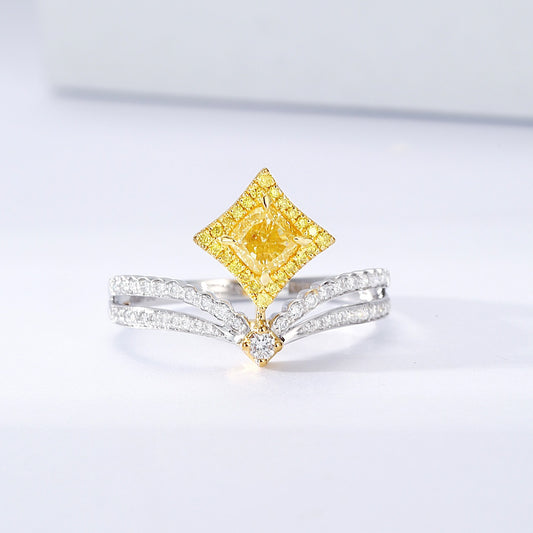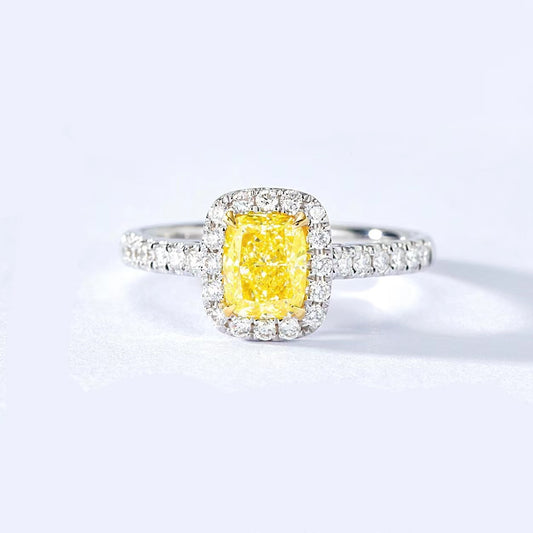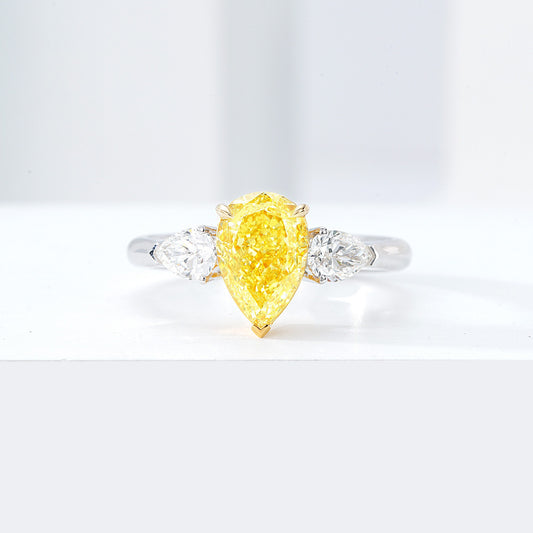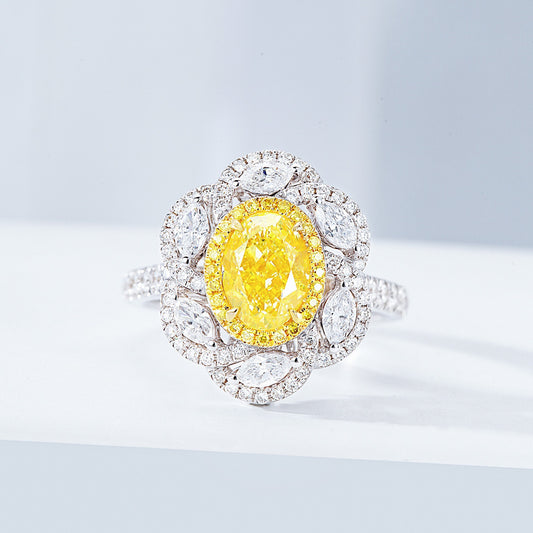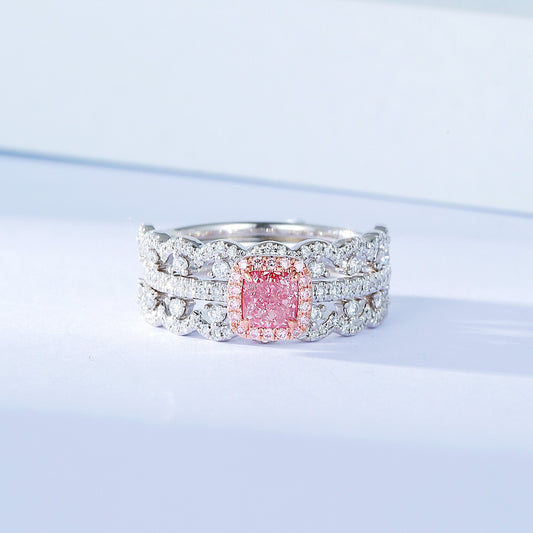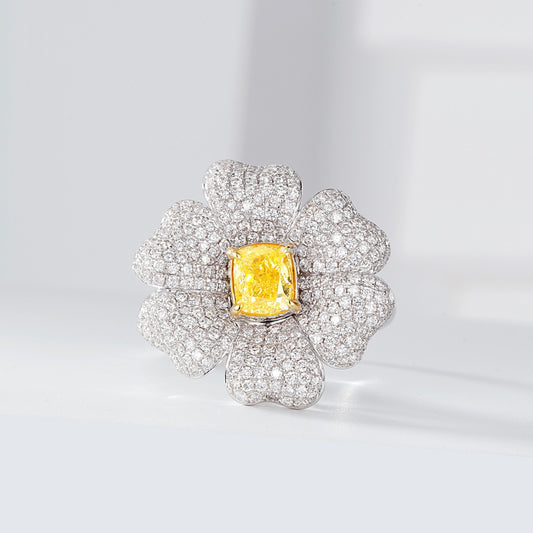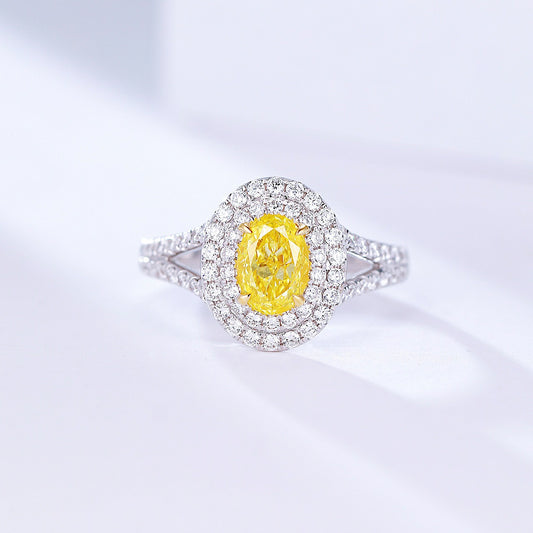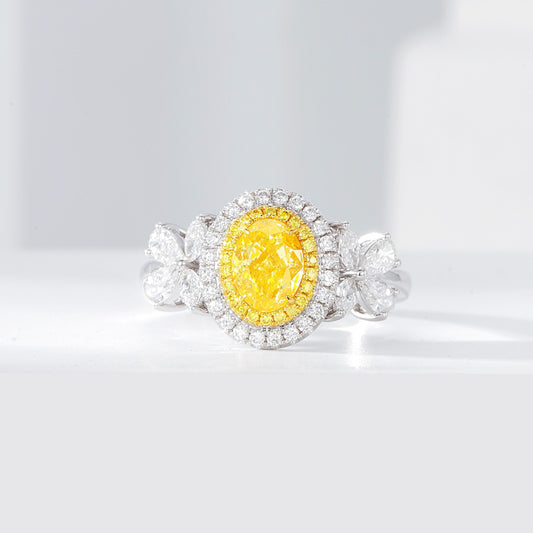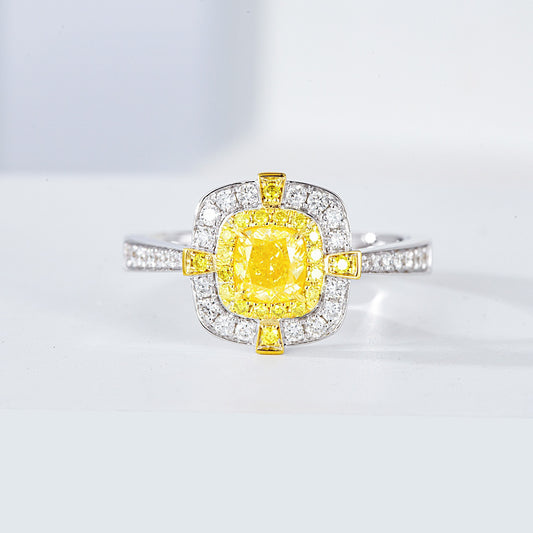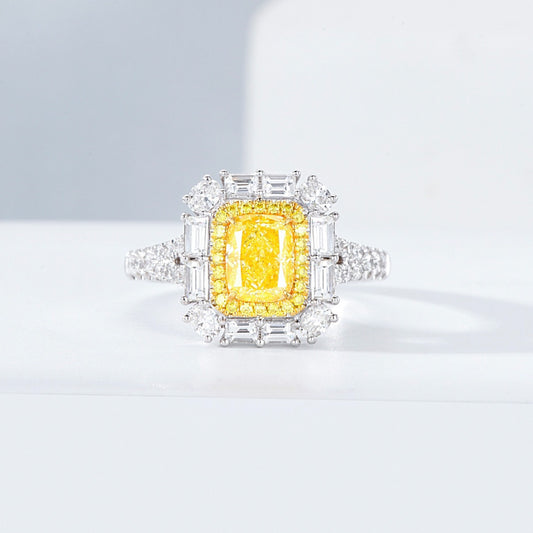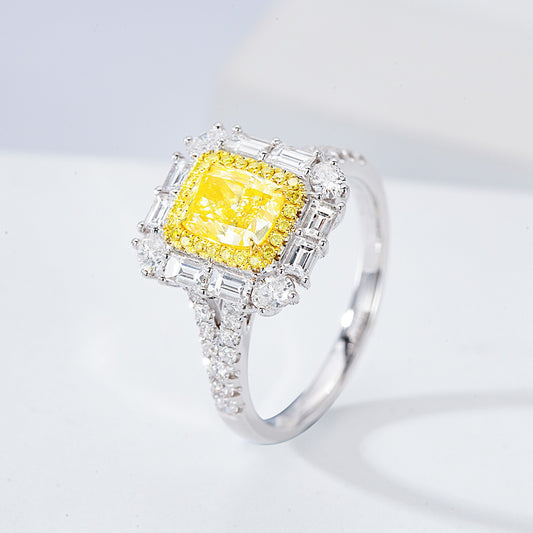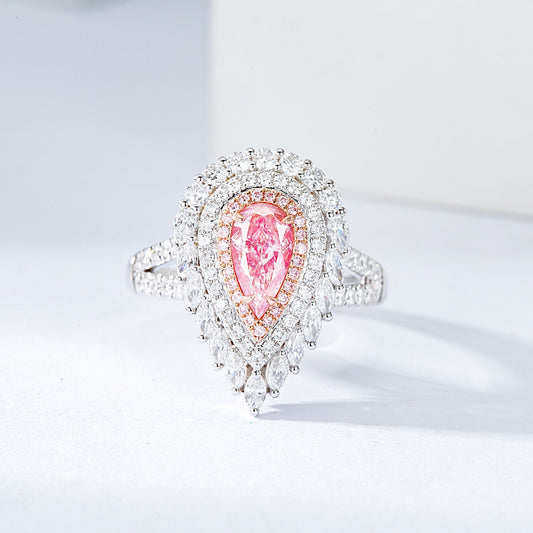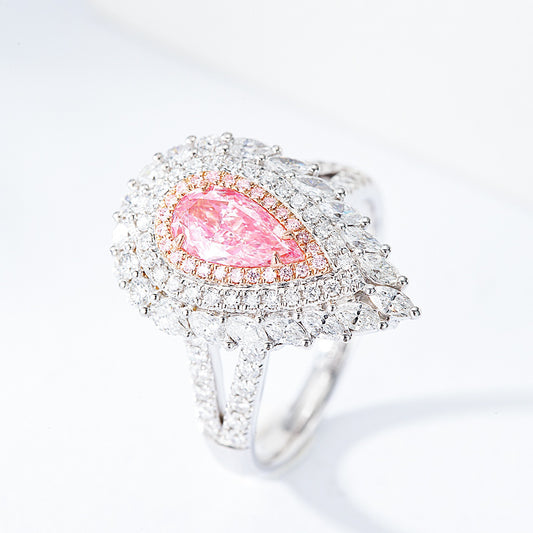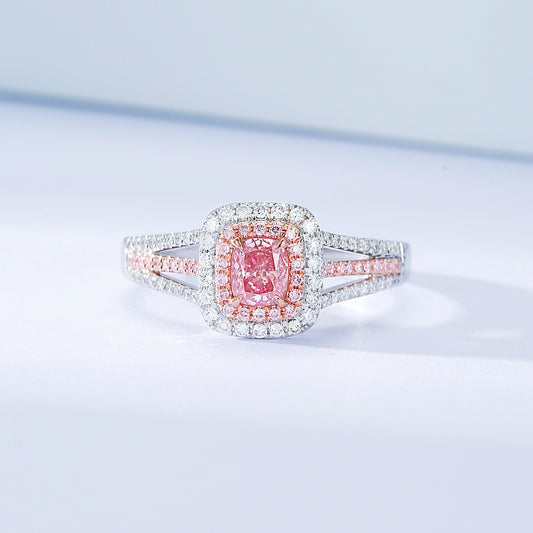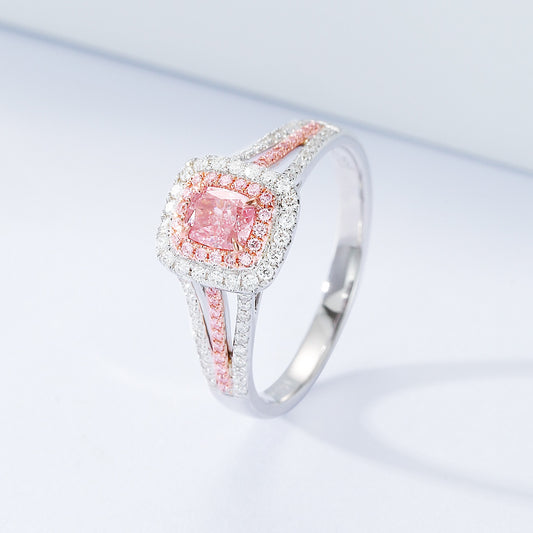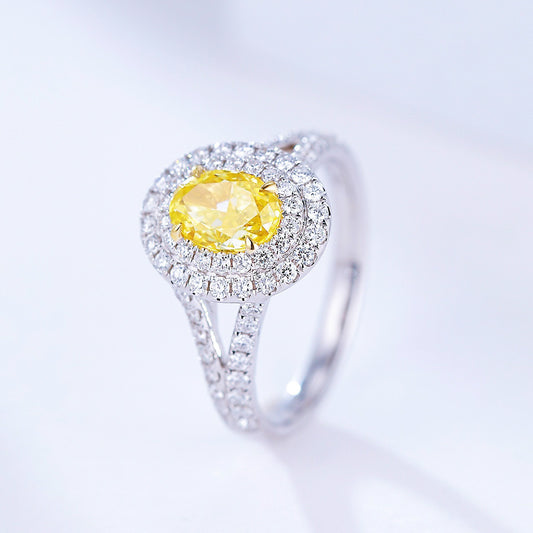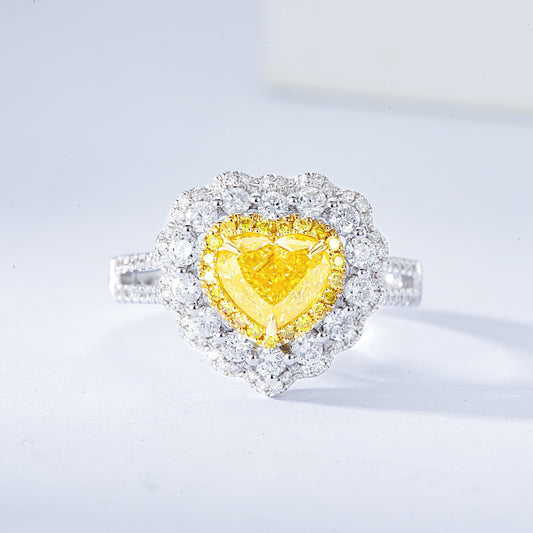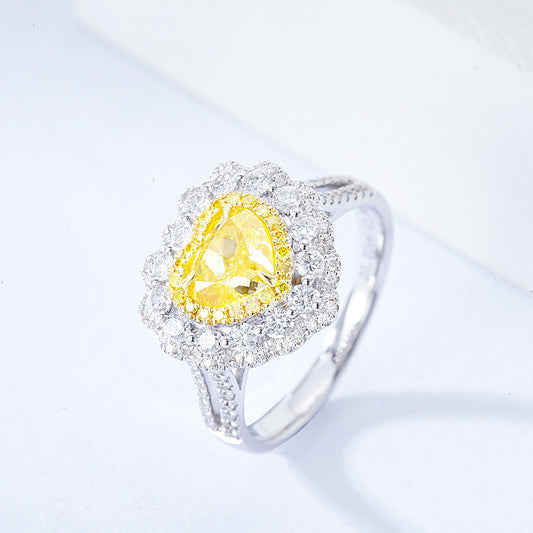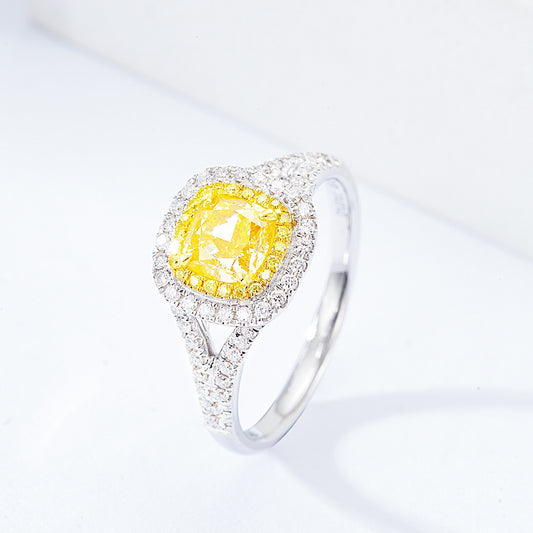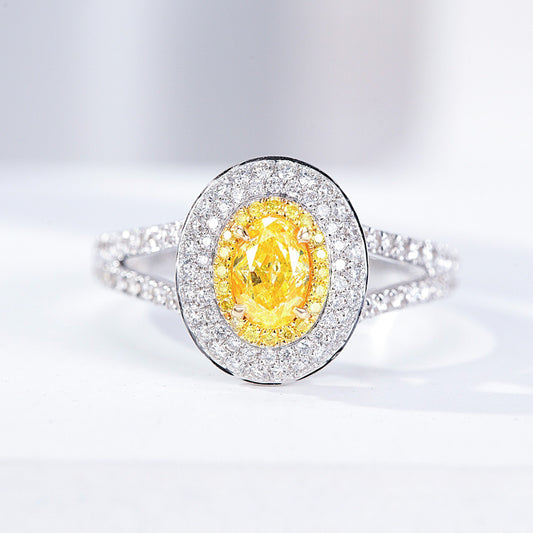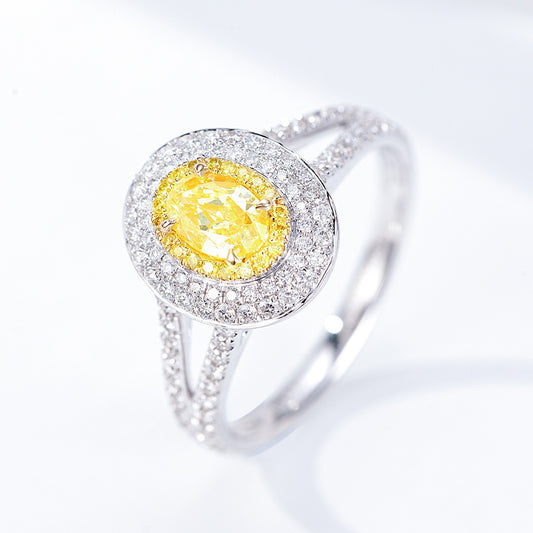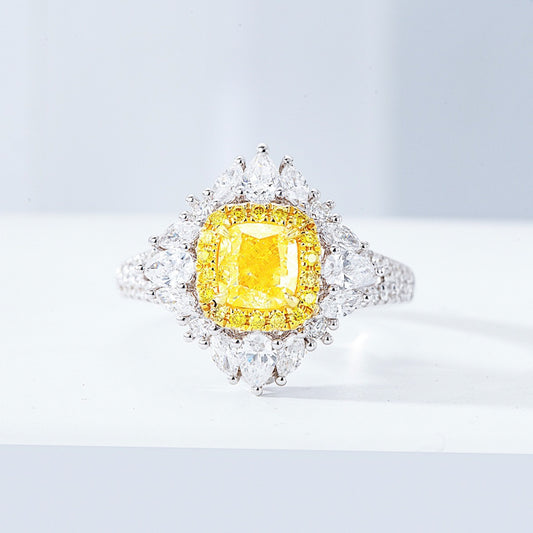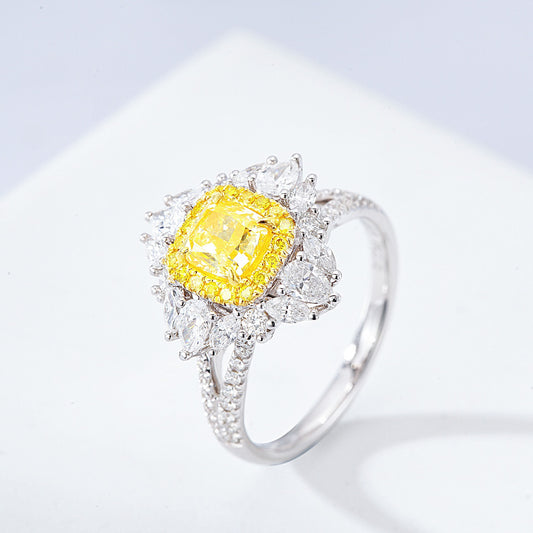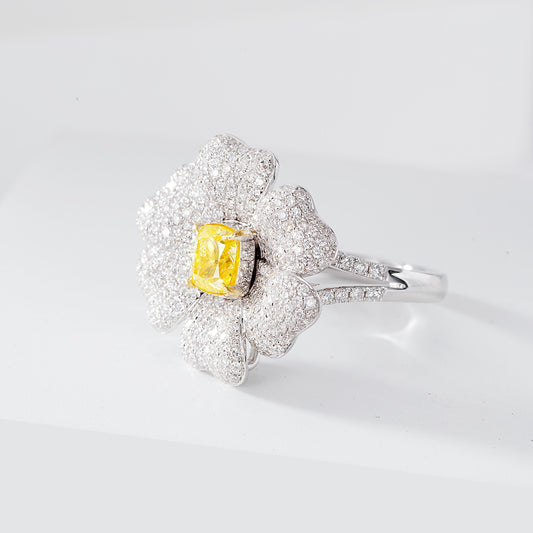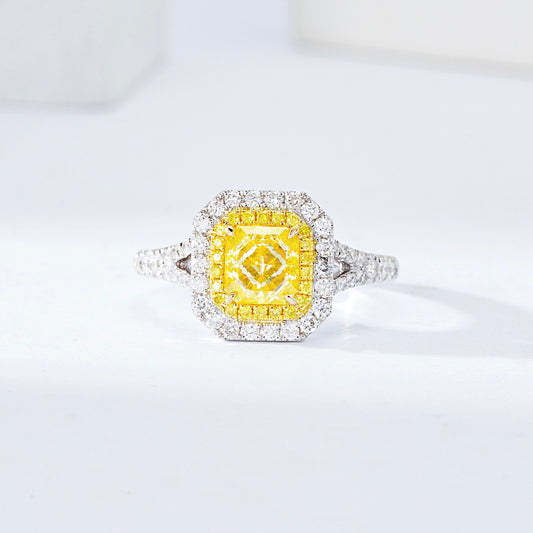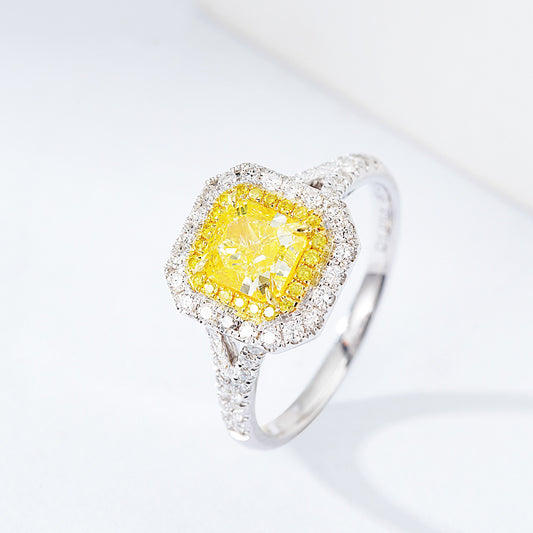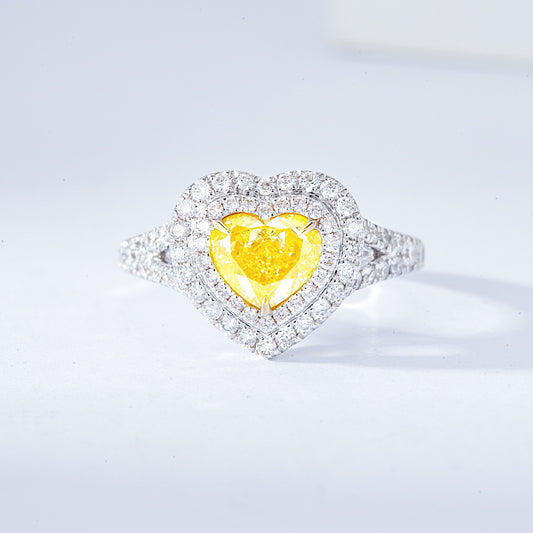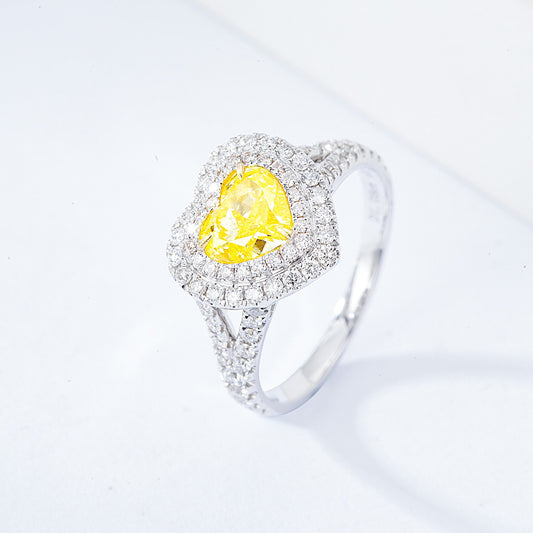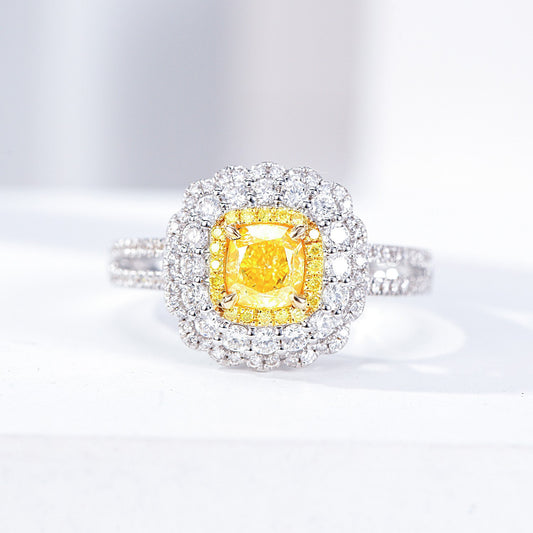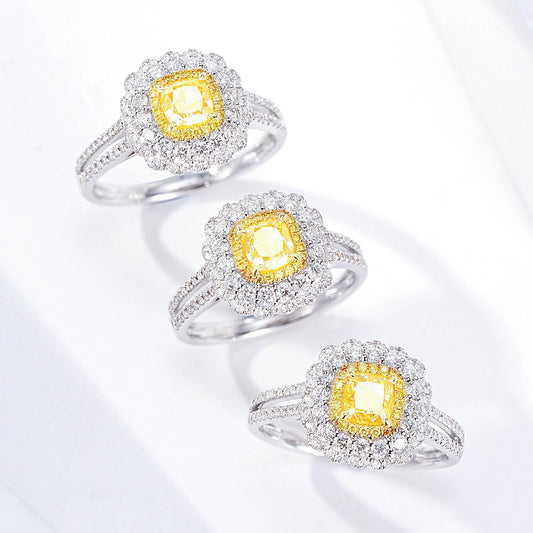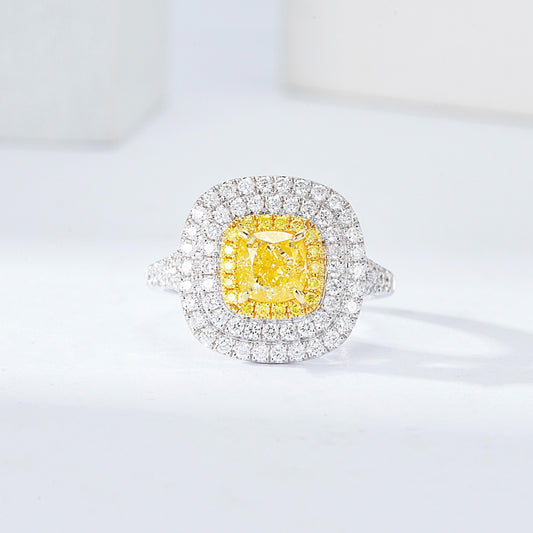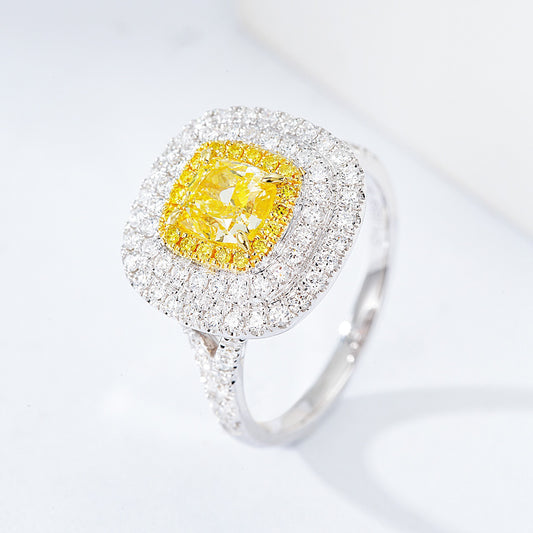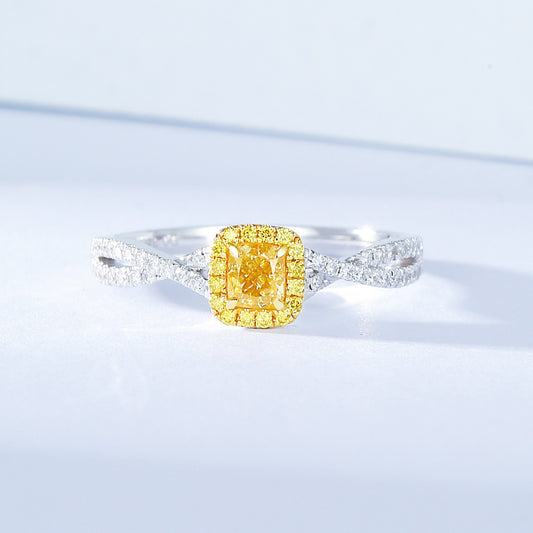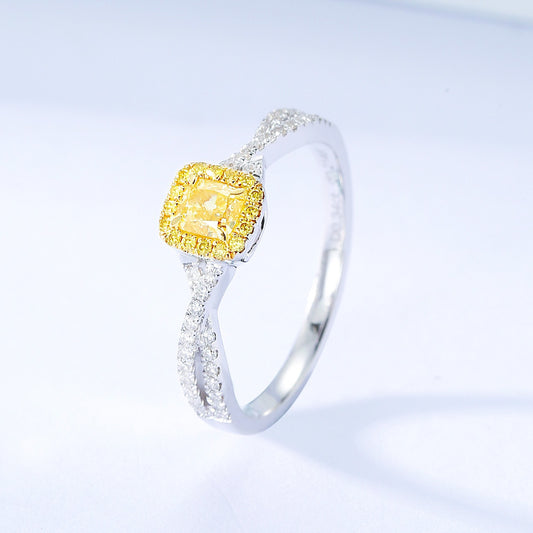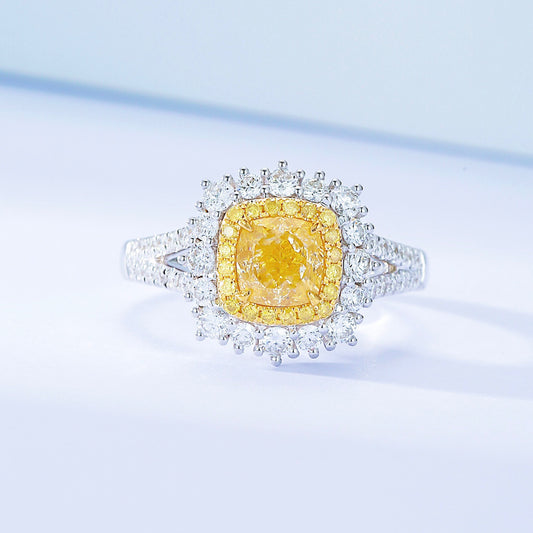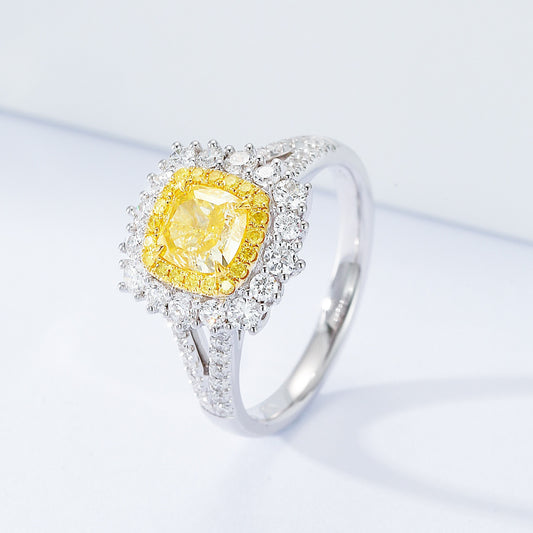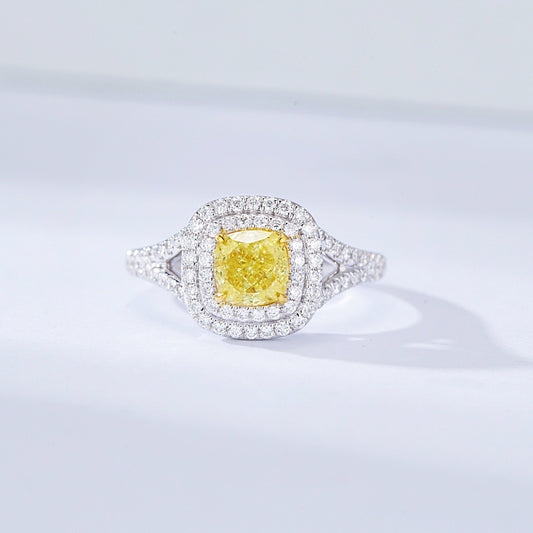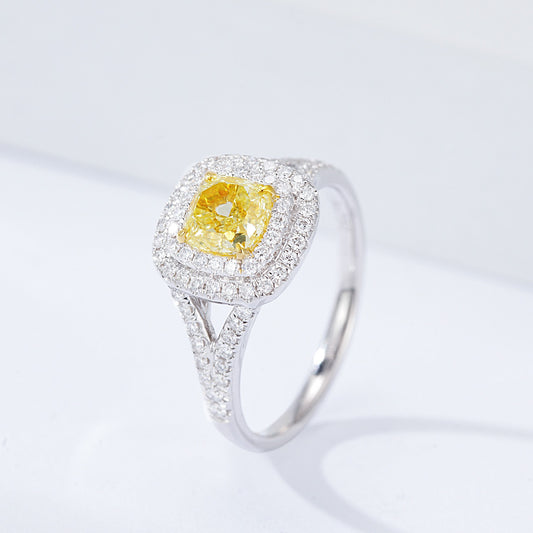-
Cushion Cut Yellow Diamond Halo Engagement Ring with Pavé Setting in 18K White Gold
A detailed halo composed of differing round and baguette-cut white diamonds surrounds a yellow diamond with the 1-carat weight that’s at the center. This ring is an excellent choice for those who admire luxury as well as timeless beauty since it contrasts between the bright white diamonds and vivid yellows are so striking and elegant. In addition, the pavé-set band adds to its brilliance which ensures that the overall design remains outstanding among other pieces of jewelry. A luxury Cushion-Cut Yellow Diamond Ring with White Diamond Halo with a total weight of 1.98 carats, showcasing a certified 1.00 carat cushion cut diamond.- From $3,170.00
- From $3,170.00
- Unit price
- per
-
Pear Shaped Pink Diamond Ring with Double Halo and Marquise Accents
Showcasing an astonishing pear-shaped pink diamond at its centre, this stunning ring is encapsulated beautifully within pink and white diamonds in a dual halo. A number of marquise-shaped stones have been included in the design which add to its intricate layers making it appear luxurious and imperial as well. The vibrant pink gem at the heart of all concerns itself with delicate halo and overlapping diamond ornaments cascade; hence it is the perfect ring for those who want both refinement and daring designs at the same time. An elegant Pear-Shaped Pink Diamond Ring with a total weight of approximately 1.85 carats, featuring 0.70 carat natural diamonds.- From $8,660.00
- From $8,660.00
- Unit price
- per
-
Cushion Cut Pink Diamond Ring with Double Halo and Split Shank Design
Decorated with a double circle of square-cut pink diamonds, this beautiful ring has a cushion-shaped pink one as its centerpiece. This elegant ring glows with vibrant colors due to paired circles of white and pink stones around the main gem. Adorned with pavé set pink and white diamonds, the shank is split which gives it complex feel as well as an air of luxury. An ideal choice for someone who values gracefulness void of monotony is the harmonious clash between white diamonds and pink diamonds found in the engagement ring. A luxury Cushion Cut Pink Diamond Ring with Double Halo and Split Shank Design with a total weight of approximately 0.66 carat, featuring 0.35 carat cushion diamonds.- From $3,600.00
- From $3,600.00
- Unit price
- per
-
Oval Yellow Diamond Double Halo Engagement Ring with Split Shank
In its midst, a center arrangement of a one-carat oval yellow diamond is among the captivating rings around. The major characteristics are its dual circle of white diamonds which not only adds to the ring’s brilliance but also leaves sparkles on it. On either side of the split shank, there are pavé settings all round that make it look even more sophisticated than ever before. The bright yellow center stone stands out prominently against a backdrop made up of glittering white diamonds thereby imparting an eternal feel as well as opulence to this piece when considered altogether. It is ideal for people who want classics with some inclusions from contemporary world. An Oval Yellow Diamond Double Halo Engagement Ring with Split Shank with a total weight of approximately 1.70 carats.- From $2,790.00
- From $2,790.00
- Unit price
- per
-
Heart Shaped Yellow Diamond Engagement Ring with Pavé Halo Setting
This genuinely mesmerizing ring comprises of a striking yellow diamond heart shaped stone weighing 1 carat nested amidst two glittering circular layers of diamonds. The fiery color of the diamond is complimented exceptionally by the white stones, inspired by the warmth of love and opulence. An charming Heart-Shaped Yellow Diamond Ring with a total weight of 1,68 carats, showcasing a 1.00 carat heart shape diamond.- From $2,990.00
- From $2,990.00
- Unit price
- per
-
Cushion Cut Yellow Diamond Engagement Ring with Pavé Halo Setting in 18K White Gold
This exclusive engagement ring has as a centrepiece a cushion-shaped 1-carat yellow diamond. The lovely yellow diamond in the middle is bordered by two concentric halos of different diameter, one of white diamonds and the other of yellow. The jersey split band encrusted with delicate diamonds lends accessibility to such an exquisite style. A charming Cushion Cut Yellow Diamond Ring with a total weight of 1.38 carats, showcasing a certified 1.00 carat cushion shape diamond.- From $2,680.00
- From $2,680.00
- Unit price
- per
-
Oval Cut Yellow Diamond Engagement Ring with Pavé Halo Setting in 18K White Gold
A remarkable engagement ring is what you are looking at right now which will make you understand the brilliance of the Creation. A yellow oval diamond nested within two concentric halos of the brightest white diamonds is the first piece of this engagement ring. This awesome effect is because of the combination of the contrast between the white gold of the ring and the awesomeness of the colorful diamond sandwiched in the middle. To enhance the effect, you will find the split-shank band with surrounding pave diamonds enhancing the design and the perfection of the timeless chic and the contemporary luxury. A wonderful Oval Yellow Diamond Engagement Ring with a total weight of 0.96 carat, showcasing a 0.50 carat yellow diamond.- From $1,320.00
- From $1,320.00
- Unit price
- per
-
Cushion Cut Yellow Diamond Engagement Ring with Pavé Halo Setting in 18K White Gold
The magnificent yellow diamond is skillfully put in place to attract everyone’s attention in this beautiful 1 carat cushion cut yellow diamond ring. The rich yellow color of the diamond is decorated in a white gold inlaid setting that consists of round brilliant diamonds. The detailed inlaid setting will only make it possible to appreciate the dazzling sparkle of the diamond and the remaining plain white gold of the dull band is a subtle nod to the definition of ageless charm. This ring will really not refer to less than tailor fitting in terms of every grand scheme of things, it is indeed an ornament worn for significant events and pack a punch inside a square inch or five square centimeters of diamonds. An charming Cushion Cut Yellow Diamond Ring with a total weight of 2.00 carats, showcasing a certified 1.00 carat natural diamond.- From $3,150.00
- From $3,150.00
- Unit price
- per
-
Cushion Cut Yellow Diamond Flower Engagement Ring
At its core is a 1 carat yellow diamond of cushion-like shape in a special flower-patterned form glittering with pavé set white diamonds. It complements the majestic yellow center stone against sparkling diamond petals giving way for a refined nature-inspired art-piece. Split shank adds up to the floriated theme that is why it is a perfect mix of classical sophistication and modern trendiness. An special Cushion Cut Yellow Diamond Flower Ring with a total weight of approximately 2.11 carats, featuring 1.00 carat cushion diamonds.- From $3,250.00
- From $3,250.00
- Unit price
- per
-
Radiant Cut Yellow Diamond Halo Engagement Ring with Split Shank Design
The beauty and brilliance of the radiant yellow diamond engagement ring are sure to make the recipient the happiest person on earth. I further added two rows of melee diamonds in yellow and white forming another halo for increased shine and to frame the yellow diamond. The shank is further split and this gives even more alluring effect thanks to the added white diamonds. A elegant Radiant Cut Yellow Diamond Halo Engagement Ring with a total weight of 1.45 carats, showcasing a certified 1.00 carat radiant cut diamond.- From $2,970.00
- From $2,970.00
- Unit price
- per
-
Heart Shaped Yellow Diamond Engagement Ring with Pavé and Halo Setting
This genuinely mesmerizing ring comprises of a striking yellow diamond heart shaped stone weighing 1 carat nested amidst two glittering circular layers of diamonds. The fiery color of the diamond is complimented exceptionally by the white stones, inspired by the warmth of love and opulence. An charming Heart-Shaped Yellow Diamond Ring with a total weight of 1,62 carats, showcasing a certified 1.00 carat heart shape diamond.- From $2,790.00
- From $2,790.00
- Unit price
- per
-
Cushion Cut Yellow Diamond Engagement Ring with Double Halo and Pavé Band
The cushion cut yellow diamonds and brilliant circles made of yellow and white diamonds makes the center of this ring rich with color. The diamond that is yellow in color is exceptional in terms of color purity and light return, an aspect that is further accentuated by the surrounding halos. The pavé-set band of this piece of jewelry adds a tint of brilliance which makes this make it perfect for any special event. Displayed here is a charming Cushion Cut Yellow Diamond Ring with a total approximate diamond weight of 1.16 carats, showcasing a certified 0.60 carat cushion cut diamond.- $3,130.00
- $3,130.00
- Unit price
- per
-
Cushion Cut Yellow Diamond Triple Halo Engagement Ring with Pavé Setting - 1.00 Carat
This cushion cut yellow diamond ring embeds you in ultimate luxury, being highly deluxe and fancy. The design of both the gold and the sides of central cushion cut yellow diamond is rather classical. The ring also has three flashy halos, one on every side of the main diamond. The setting on the side completes the design with some brilliance and splendor.The entire ring features diamonds with fine gold chain enveloping the center yellow diamond and diamonds along the sides which make it a pavé band. A captivating Cushion Cut Yellow Diamond Ring, showcasing a cushion cut diamond.- From $3,280.00
- From $3,280.00
- Unit price
- per
-
1.00 Carat
-
1.50 Carat
-
Elegant Cushion Cut Yellow Diamond Ring with Twisted Band Design
In a very traditional manner combined with the 21st century spin, a cushion cut yellow diamond ring is made. Additionally, the center diamond’s warm color is enhanced by a twisted band that has delicate surrounding halo for some touch of class. Upon wearing it for special occasions or using it as part of a statement jewelry piece, this ring will direct people’s attention to you and make them admire it at the same time. This ring has a perfect balance between luxury design and timelessness. An opulent Cushion Cut Yellow Diamond Halo Engagement Ring with a total weight of 0.51 carat, showcasing a certified 0.30 carat cushion cut diamond.- $1,520.00
- $1,520.00
- Unit price
- per
-
Cushion Cut Yellow Diamond Engagement Ring with Pavé Halo Setting in 18K White Gold
Its center is a 1 carat cushion cut yellow diamond that glows with warmth and brilliance having a mesmerizing effect to them. Around the lively yellow diamond is a shimmering halo of diamonds, giving off a different light each time the angle changes. In addition, the pavé diamond band makes it even more luxurious, thus enhancing its statement of elegance. A excellent Cushion Cut Yellow Diamond Halo Ringwith a total weight of 1.76 carats, showcasing a certified 1.00 carat cushion cut diamond.- From $2,990.00
- From $2,990.00
- Unit price
- per
-
Cushion Cut Yellow Diamond Double Halo Engagement Ring with Split Shank
This exclusive engagement ring features a stunning 1-carat cushion-cut yellow diamond as its centrepiece, surrounded by two concentric halos of sparkling white diamonds. The delicate diamond-encrusted split band further enhances the accessibility and elegance of this exquisite design. The ring boasts a total weight of 1.39 carats, with the certified 1.00-carat yellow diamond taking centre stage in a charming, elegant setting.- From $2,790.00
- From $2,790.00
- Unit price
- per
Split Shank Engagement Rings
Split shank engagement rings offer a captivating blend of classic sophistication and contemporary flair, making them a distinctive choice for symbolizing love and commitment. This unique design, characterized by a band that gracefully divides as it approaches the center stone, creates an airy, architectural elegance that beautifully showcases the chosen diamond or gemstone. With their inherent versatility and ability to enhance the brilliance and perceived size of the main stone, split shank rings stand as a testament to timeless design and personal expression. They are more than just adornment; they are a sophisticated statement, merging rich history with modern artistry to create a truly unforgettable symbol of a shared future.
FAQs about Split Shank Engagement Rings
A split shank engagement ring is distinguished by its band, or shank as it's known in jewelry terms, which divides into two or more separate strands as it nears the setting for the center gemstone. This division can vary significantly in its execution; the split might be subtle and occur only near the top of the ring, or it can extend further down the band, creating a more dramatic effect.
The defining characteristic of this style is the open space, often referred to as negative space, created between the divided strands. This opening, which can form a V-shape or parallel lines, is not merely a design flourish. It plays a crucial role in the ring's overall aesthetic, drawing the eye towards the central diamond or gemstone and enhancing its prominence. Beyond its visual appeal, the separated strands can also contribute to the structural integrity of the ring, offering enhanced support, particularly for larger or more prominent center stones. This functional aspect, combined with its distinctive beauty, makes the split shank a thoughtfully engineered design.
A: The split shank setting is remarkably versatile, lending itself to a wide array of stylistic interpretations. This adaptability allows individuals to find a design that truly reflects their personal taste, from understated elegance to bold and intricate creations. Some of the most notable variations include:
- Plain or Solitaire Split Shank: This classic iteration features polished metal strands that divide to elegantly frame a single center stone, emphasizing its singular beauty. The simplicity of the metalwork keeps the focus firmly on the gemstone.
- Pavé Split Shank: In this popular style, the surfaces of the split strands are encrusted with small, closely set diamonds (pavé-set). This adds a continuous layer of sparkle, enhancing the ring's overall brilliance and luxurious feel.
- Halo Split Shank: This design combines two powerful visual elements: the split shank and a halo of smaller diamonds encircling the main center stone. The halo magnifies the perceived size and sparkle of the center gem, while the split shank adds further dimension and detail to the band.
- Twisted Split Shank: The individual strands of the shank twist around each other as they approach the center setting. This creates a sense of movement and fluidity, often evoking an organic or romantic feel.
- Double Split Shank: This variation features a band that initially splits into two, with each of those strands then splitting again, resulting in four distinct strands approaching the center stone. This adds a greater level of complexity and visual interest.
- Multi-Row Split Shank: Some designs take the division further, incorporating three or more strands on each side, which can be adorned with diamonds or feature intricate metalwork.
- Vintage-Inspired Split Shank: Drawing inspiration from historical periods like the Edwardian or Art Deco eras, these rings often incorporate fine detailing such as milgrain (tiny bead-like edges), filigree (delicate wirework), or elaborate engravings on the split shanks.
- Criss-Cross Split Shank: The strands of the shank cross over one another as they lead up to the center stone, offering a contemporary and dynamic look.
- Two-Tone Split Shank: These designs utilize two different colors of precious metal—for instance, a white gold shank with rose gold accents near the split or setting—to create a striking contrast and highlight the design's details
Each of these variations caters to different aesthetic preferences. A plain split shank offers modern minimalism, while a pavé or halo split shank delivers maximum sparkle. Twisted designs can appeal to those seeking a more romantic or unique feel, and vintage-inspired options speak to an appreciation for historical craftsmanship. Understanding these distinctions allows for a more informed choice aligned with individual style.
The split shank design is not a recent invention but boasts a rich and fascinating history, with its origins traceable to ancient civilizations. Archaeological findings have revealed examples of split band rings in Roman and Greek jewelry, where the design served not only aesthetic purposes with intricate engravings but also a practical function, allowing for easier size adjustment.
During the Renaissance period, split shank rings gained favor among European nobility. These pieces were often elaborately adorned with delicate filigree work and precious gemstones, serving as symbols of wealth and status. The 19th century, particularly the Victorian Era, witnessed a significant resurgence in their popularity. Influenced by Queen Victoria, who championed sentimental motifs in jewelry, split shank rings from this time were frequently engraved with romantic messages or set with birthstones, transforming them into cherished tokens of love and affection.
The Edwardian (roughly 1901-1910) and Art Nouveau (late 19th to early 20th century) eras further cemented the split shank's prominence. These periods celebrated intricate metalwork and delicate, lace-like appearances in jewelry, for which the split shank was an ideal canvas. The Art Nouveau movement, in particular, embraced the flowing lines of the split shank, often incorporating nature-inspired motifs like leaves and floral patterns.
The style experienced another wave of widespread popularity during the Art Deco period of the 1920s and 1930s, where it was viewed as a modern and sophisticated design. This was followed by yet another surge in the mid-20th century, from the 1960s to the 1970s.
Today, contemporary jewelers continue to draw inspiration from this historic design, blending traditional craftsmanship with innovative techniques. Modern interpretations often feature colored gemstones, mixed metals, and varying numbers of splits, ensuring the style remains relevant and captivating. The enduring appeal of the split shank across such diverse historical periods underscores its fundamental aesthetic strength and remarkable adaptability, marking it not as a fleeting trend but as a design with proven longevity. This historical depth provides reassurance for those seeking a ring that will remain stylish for years to come.
Split shank engagement rings are rich in symbolism, with their distinctive design lending itself to various meaningful interpretations regarding love and partnership. The most prevalent and widely recognized symbolism is that of two individual paths converging into one. The two (or more) strands of the shank represent two separate lives, experiences, and journeys. As these strands meet at the center stone—the focal point of the ring—they symbolize the couple coming together in love, unity, and commitment, forging a new, shared path forward while honoring their individuality.
Beyond this core meaning, the split shank design can also represent:
- A Shared Future and Overcoming Challenges: The way the band divides and then reconnects at the setting can be seen as a metaphor for the couple's journey through life. It acknowledges that challenges and obstacles may arise, but their love and commitment (represented by the unified setting holding the precious stone) provide the strength to overcome them, leading to an even stronger and more resilient partnership.
- An Unbreakable Bond: The structure of the ring, with its strands supporting the central gem, signifies the strength and solidarity of the relationship and the commitment to stand side-by-side through all of life's moments.
- Continuity and Connection: The design can evoke a sense of connection to both the past and the future. As the individual strands merge, they represent the transition from separate histories to a shared present and an unwritten future together, bridging generations and creating an ongoing narrative of love.
While these are common and beautiful interpretations, the symbolism of an engagement ring can also be deeply personal. The unique design of a split shank allows couples to imbue it with their own specific meanings and sentiments, making the ring an even more powerful and intimate emblem of their unique love story.
Opting for a split shank engagement ring comes with a host of appealing advantages that contribute to its enduring popularity. These benefits range from enhanced visual characteristics to practical design elements:
- Enhanced Brilliance and Sparkle: The open architecture of the split shank allows significantly more light to enter the center diamond or gemstone from various angles. This increased light interaction maximizes the stone's internal reflection, resulting in superior brilliance, fire, and sparkle.
- Illusion of a Larger Center Stone: One of the most celebrated attributes of the split shank setting is its ability to make the center stone appear larger than its actual carat weight. The way the shanks diverge creates negative space and a broader frame around the gem, enhancing its visual presence and prominence. This optical effect offers a significant aesthetic impact.
- Enhanced Focus on the Center Stone: The lines of the split shank naturally guide the viewer's eye inward, directly towards the main diamond or gemstone, making it the undeniable focal point of the ring.
- Versatility and Customization: Split shank designs are incredibly versatile, adaptable to a wide range of styles, from classic and understated to modern and elaborate. They offer ample opportunities for personalization, including the choice of metal, the addition of accent stones, variations in band width and texture, and the incorporation of intricate details like engraving or filigree.
- Unique Visual Impact: The distinctive separation of the band creates an attention-grabbing and sophisticated appearance that sets it apart from traditional single-band rings. It offers a sense of architectural beauty and dimension on the hand.
- Added Stability for the Center Stone: The dual or multiple strands of a split shank can provide increased support and security for the center stone, which is particularly beneficial for larger or higher-set gemstones.
- Vintage Appeal and Timeless Elegance: With roots in historical jewelry designs, particularly the Art Nouveau and Edwardian eras, the split shank carries an inherent vintage charm and a sense of timeless sophistication.
- Additional Surface Area for Embellishments: The divided shanks offer more surface area than a single band, providing a perfect canvas for adding pavé-set diamonds, channel-set gemstones, or other decorative elements, further enhancing the ring's sparkle and intricacy.
These combined benefits mean that a split shank ring can offer enhanced visual value, allowing for a strikingly beautiful and impressive ring that reflects individual style and the significance of the commitment it represents.
Yes, it is a widely recognized characteristic of split shank engagement rings that they can create a compelling optical illusion, making the center diamond or gemstone appear larger and more prominent than its actual carat weight might suggest. This visual enhancement is not due to any change in the stone itself, but rather to the clever design principles inherent in the split shank style. Several mechanisms contribute to this effect:
- The Role of Negative Space: The gaps created by the split in the shank introduce negative space around the center stone. This open area provides a contrast that can make the gemstone itself appear more substantial and visually dominant. The eye perceives the stone as larger relative to the open spaces flanking it.
- Framing Effect: The individual strands of the split shank act as a natural frame, directing the viewer's gaze inward towards the center stone. This focused attention enhances the stone's importance and perceived size within the overall composition of the ring.
- Increased Overall Surface Area: A split shank often results in a wider overall presence on the finger compared to a single, slender band. This increased surface area covered by the ring's design can contribute to the impression that the central element—the diamond—is also larger and more commanding.
- Enhanced Light Performance: While not directly making the stone physically larger, the open design of a split shank allows more light to reach the diamond from multiple angles. This improved light exposure boosts the diamond's brilliance and sparkle. A stone that is more brilliant and lively can often appear more visually impressive and, by extension, larger.
It is important to understand that this is an illusion of size. However, this optical advantage is a significant and valued feature of the split shank design, allowing for a ring that can have a more substantial and eye-catching appearance without necessarily requiring a larger or more costly center stone. The effectiveness of this illusion can also depend on the specific proportions of the split, the width of the bands, and the size and shape of the center stone itself.
Yes, split shank engagement rings are generally considered comfortable for everyday wear, with many designs offering a surprisingly flexible and accommodating fit. However, as with any ring style, several factors contribute to its overall comfort:
- Quality of Craftsmanship: A well-designed and meticulously crafted shank is paramount. Smoothly finished edges, a balanced distribution of weight, and a well-proportioned split are essential. Poor craftsmanship can lead to sharp edges or an awkward fit.
- Band Width and Profile: The width of the individual strands and the overall width where the shank splits can influence comfort. Very wide bands might feel more constricting to some individuals, particularly those with smaller hands or shorter fingers. The profile of the bands (e.g., flat, rounded, knife-edge) also plays a role; comfort fit designs, which feature a slightly rounded interior surface, are specifically engineered to enhance wearability by reducing friction and pressure points.
- Overall Ring Design: The height of the center stone's setting (profile), the size and shape of the gemstone, and how the split portion of the shank sits against the adjacent fingers will all impact the perceived comfort. Low-profile split shank designs, where the center stone sits closer to the finger, are often more practical and comfortable for individuals with active lifestyles or those who work with their hands.
- Proper Sizing: Accurate sizing is crucial for any ring, and especially for a design like a split shank that has multiple points of contact with the finger. An improperly sized ring will inevitably be uncomfortable.
While the design itself can be very comfortable, individual perception of comfort is subjective and can vary based on finger shape, knuckle size, and personal sensitivity to the feel of a ring. For instance, some wearers might find the gaps in a split shank design more noticeable than a solid band. It is always advisable to try on different styles if possible, or to consult with a knowledgeable jeweler who can offer insights into how specific design features might affect comfort for an individual.
Split shank engagement rings are quite versatile and can be adapted to complement various hand shapes and finger types, largely due to the wide range of design possibilities within the style. However, certain characteristics of the split shank make it particularly flattering for specific types:
- Wide Fingers: Split shank designs are often recommended for individuals with wider fingers. The split in the band creates an appearance of greater width across the top of the finger, which can help to balance the breadth of the finger itself. The negative space can also draw the eye, and the overall effect can be a slimming illusion for the finger. Rings that take up more surface area, like some split shank styles, tend to look fabulous on wider fingers.
- Long Fingers: Individuals with long fingers can typically carry off more elaborate or larger ring designs, and the dimension offered by a split shank, especially if it's a bolder or more detailed version, can look very proportionate and elegant.
- Short Fingers: For those with shorter fingers, the goal is often to create an illusion of length. While very wide split shanks might not be ideal, a delicately executed split shank, particularly one paired with an elongated diamond shape (like an oval, pear, or marquise), can be flattering. If the split draws the eye vertically up the finger towards the stone, it can contribute to this lengthening effect. Narrower overall band widths are generally preferred for shorter fingers.
- Small Hands/Slender Fingers: Similar to short fingers, proportion is key. A delicate split shank with thinner strands and a appropriately sized center stone can look beautiful without overwhelming a smaller hand or slender fingers.
The adaptability of the split shank design is its strength. The width of the split, the thickness of the bands, the degree of ornamentation (e.g., pavé, plain metal), and the choice of center stone all contribute to how the ring will look on a particular hand. For example, a split shank that divides high up near the center stone and maintains relatively thin individual strands might be suitable for a wider range of finger types, including shorter or slender ones. Conversely, a design where the split starts lower on the finger and creates a very broad surface at the top might be better suited to longer or wider fingers. Consulting with a jeweler can help in selecting or customizing a split shank design that achieves the most flattering proportions for an individual's unique hand characteristics.
Finding a wedding band that pairs harmoniously with a split shank engagement ring can sometimes be tricky due to the engagement ring's distinctive band structure. The primary challenge lies in how the split shank, especially if it has a curve or widens near the center stone, interacts with a straight wedding band. Often, a standard straight band will not sit flush against the engagement ring, resulting in a noticeable gap. However, there are several excellent solutions and styles that create a beautiful and cohesive bridal set:
- Contoured or Curved Wedding Bands: These are often the most popular and effective solution. Contoured bands are specifically designed with a curve or notch that allows them to nestle snugly against the profile of the engagement ring, including the split shank and center setting, creating a seamless, flush fit.
- Chevron (V-Shaped) Wedding Bands: If the split shank design or the shape of the center stone (like a marquise or pear) creates a pointed silhouette, a V-shaped chevron band can complement it perfectly, fitting into the point and enhancing the overall design.
- Simple Straight Bands (with Considerations): A plain metal or subtly adorned straight wedding band can work if:
- The engagement ring's setting is high enough to allow the wedding band to slide underneath without a significant gap.
- The wearer appreciates or doesn't mind a small, visible gap between the two rings. Some even embrace this gap as part of the style.
- Matching Pavé Bands: If the split shank engagement ring features pavé-set diamonds, choosing a wedding band with a similar style and size of pavé diamonds can create a beautifully coordinated and brilliant look. Ensuring the diamond quality and setting style are consistent is key for visual harmony.
- Custom-Fitted Wedding Bands: For highly unique, asymmetrical, or intricate split shank designs, a custom-made wedding band is often the ideal choice. A jeweler can design the wedding band to perfectly mirror the contours of the engagement ring, ensuring an absolutely flawless fit.
- Mimicking Bands: If the split shank has a distinctive feature, like a twist, a wedding band that incorporates a similar twisted design can create a very intentional and complementary pairing.
- Enhancer Bands (Ring Guards): Some enhancer bands, which consist of two bands joined by a bar at the bottom, are designed to have the engagement ring sit between them. Certain styles of enhancers might complement a split shank, particularly if they echo its design elements.
Key Considerations When Pairing:
- Metal Consistency: Matching the metal type and color (e.g., platinum with platinum, 14k rose gold with 14k rose gold) generally creates the most cohesive look, though mixed metals can be a deliberate stylistic choice.
- Stone Matching: If both rings have diamonds or gemstones, consider the similarity in cut, quality, and setting style.
- Overall Style Harmony: The wedding band should complement the overall aesthetic of the engagement ring, whether it's vintage, modern, classic, or ornate.
The potential difficulty in finding an off-the-shelf perfect match underscores the value of seeking expert advice from a jeweler. Many jewelers offer bridal sets where the engagement ring and wedding band are already designed to fit together perfectly, or they can provide guidance on selecting the best pairing or creating a custom solution.
While split shank engagement rings offer many beautiful benefits, there are some potential considerations or disadvantages that are important to be aware of before making a decision. Understanding these can help ensure the chosen ring aligns with the wearer's lifestyle and preferences:
- Tendency to Snag: Due to their open design, which often features more edges, corners, and sometimes intricate details like pavé settings, split shank rings can be more prone to snagging on clothing, fabrics, hair, or other objects. This is a practical consideration for individuals with very active lifestyles or jobs where their hands are frequently in contact with materials.
- Cleaning Challenges: The very features that make split shanks visually interesting—the gaps between the strands and any added embellishments—can also become traps for dirt, lotions, soap residue, and other debris. This means they may require more frequent and meticulous cleaning to maintain their sparkle compared to simpler, solid band designs.
- Resizing Complexity and Cost: As previously discussed, resizing split shank rings is generally more complex and can be more expensive than altering a single-band ring. The need to adjust multiple strands proportionally while preserving intricate details requires specialized skill.
- Difficulty in Pairing with a Wedding Band: Achieving a perfectly flush fit with a standard straight wedding band can be challenging. While solutions like contoured or custom bands exist, this is an extra consideration and potential expense that might not apply to simpler engagement ring styles.
- Potential to Overpower Smaller Center Stones: If the split shank design is particularly bold, wide, or heavily ornamented, it could visually overwhelm a very small or delicate center stone, diminishing its prominence rather than enhancing it. Careful proportioning between the shank design and the center stone is crucial.
- Comfort (Subjective): While generally comfortable, the feel of the split strands against adjacent fingers, or the overall width of the ring at its top, might be a point of subjective comfort for some individuals, especially if they are not used to wearing rings with more dimension.
It's valuable to frame these points as considerations rather than absolute disadvantages, as their significance often depends on individual priorities, lifestyle, and the specific design of the split shank ring in question. For example, someone who is meticulous about jewelry care may not find the cleaning aspect a major issue, while someone with a very hands-on job might prioritize a lower-profile, less snag-prone design. Discussing these aspects with a knowledgeable jeweler can help in selecting a split shank ring that is both beautiful and practical for the intended wearer.
- Choosing a selection results in a full page refresh.
